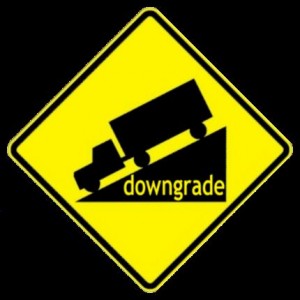
From Moody’s today comes a not unexpected downgrade for QBE. The negative outlook is a bit more surprising:
New York, April 21, 2013 — Moody’s Investors Service has downgraded the issuer and senior unsecured debt ratings of QBE Insurance Group Limited (QBE; QBE.AX) to Baa1 from A3. The action completes a review for downgrade initiated on November 14, 2012 following the company’s announcement of estimated losses arising from US-based events including Superstorm Sandy, US crop insurance, and reserve strengthening to its US commercial insurance segment, all of which hurt 2012 profitability, constraining internal capital generation and weakening fixed charge coverage. (The ratings of QBE’s LMI mortgage insurance and QBE Seguros La Buenos Aires subsidiaries are not affected by this action.) The outlook for the ratings is negative.
RATINGS RATIONALE
“The downgrade of the rating primarily reflects the group’s weakened earnings, internal capital generation and debt service coverage measures, as well as QBE’s sustained elevated financial and operational leverage profile, considered on both a nominal and tangible basis. The group’s above-average aggregate worldwide catastrophe exposures relative to capital, and its recent adverse trends in reserve adequacy are additional considerations”, according to Alan Murray, lead analyst for QBE.
Expanding on its rationale, Moody’s noted that, during a period of sustained strong core underwriting profit margins, Moody’s viewed QBE’s somewhat aggressive growth-based leverage as somewhat less of a concern, but that the weakening of debt service protection margins, and the emergence of catastrophe and casualty-based volatility remains an increased concern prospectively. Moody’s further noted that it considers QBE’s aggregate worldwide catastrophe underwriting exposures to remain high relative to the group’s capital, and that reserve adequacy — particularly in US casualty businesses — remains a concern, notwithstanding significant 2012 additions to reserves for prior accident-years. Ongoing regulatory scrutiny of the US lender-placed homeowner insurance sector, in which QBE is a market leader, will also likely lead to margin compression in that segment in the coming years, although it remains profitable for QBE.
The negative outlook reflects Moody’s expectation that recent management initiatives to refocus the worldwide group on operational effectiveness and on enhancing financial flexibility and performance will take time to implement and that the path toward restoring capital strength and deleveraging will be gradual. Moody’s focus in resolving the outlook will be on group operating performance, risk management discipline and capital decision-making in 2013 and 2014, and on the progress in deleveraging.
In rating QBE, Moody’s makes credit assessments of the company’s significant operating subsidiaries in order to determine the strength of earnings and cash flows available to the holding company. QBE’s Baa1 senior debt and issuer ratings reflect the good financial strength of the underlying operations as well as the benefits of their geographic diversity.
Factors that could lead to the restoration of a stable outlook include the following: 1) maintaining capital at or above 1.6x required Australian regulatory solvency margin under the revised APRA framework effective January 2013 (approximately 1.7x basis in effect at YE2012) and a sustained reduction in gross underwriting leverage to below 3.5x on a nominal basis, and below 5.5x on a tangible basis (excluding goodwill and other non-DPAC (deferred policy acquisitions cost) intangibles); 2) sustained reduction in adjusted financial leverage ratio to approximately 35% or less on a nominal basis, and to 45% or lower on a tangible basis (excluding goodwill and other non-DPAC intangibles); 3) sustained earnings strength and underwriting performance, resulting in consistent returns on capital at or above 10% and combined ratios in low-90% range or lower.
Factors that could lead to a further downgrade include the following: 1) deterioration in credit risk profile of one or more significant subsidiaries or regional operations; 2) sustained returns on capital below 5%; 3) sustained adjusted financial leverage above 40% on a nominal basis (or above 60% on a tangible basis, excluding goodwill and other non-DPAC intangibles), and/or a drop in earnings coverage to below 5x; 4) weakening in local solvency margin (e.g. to 1.5x or below current minimum Australian regulatory (APRA) capital levels on a sustained basis), or a persistent gross underwriting leverage ratio above 5x, or above 7x on a tangible basis (excluding goodwill and other non-DPAC intangibles); 5) significant losses due to catastrophes or other operating losses, resulting in a more-than-10% decline in shareholders’ equity over a 12-month period; or 6) further material acquisitions that would significantly increase goodwill and other non-DPAC intangibles to greater than 60% of shareholders’ equity.

